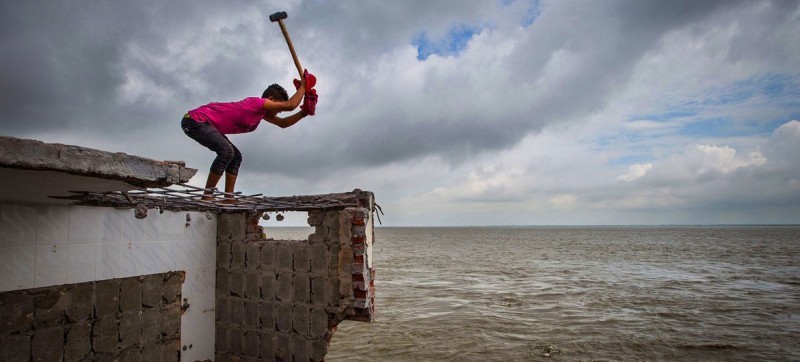Bricks are salvaged from a home damaged by erosion in Bangladesh. The impacts of climate change are already “very visible” and “happening worldwide”, the head of the UN weather agency told the start of the 55th Session of the UN’s Intergovernmental Panel on Climate Change (IPCC) which convened on Monday. The meeting opened to approve the report of the second IPCC Working Group focusing on impacts, adaptation and vulnerability to climate change which will be added to the Sixth Assessment Report later this month. The report of the first IPCC Working Group, which focussed on the physical science of climate change, influenced the work of the UN Climate Conference in Glasgow, COP26, last year.
“The impacts of #climatechange are visible and happening world-wide.” – @WMO SG Petteri Taalas at today’s opening ceremony for the 55th Session of the #IPCC. pic.twitter.com/Zvao7iM5FO
— IPCC (@IPCC_CH) February 14, 2022
World Meteorological Organization (WMO) Secretary-General Petteri Taalas reminded delegates that during COP26, “there was not a single head of State who questioned the scientific facts”, saying the message had got through and “has been heard”.
Disaster impacts
The WMO chief noted that some areas of the world such as tropical latitudes and developing countries, especially in Africa, Southern Asia, and the Pacific islands, are particularly vulnerable to climate change.
Last year WMO published a report on disaster statistics, which demonstrated that for the past 50 years, 4.5 billion people have experienced a major weather-related disaster over the past 20 years.
And while there has been a drop in casualties thanks to improved early warning services, dramatic increases in economic losses have occurred.
Only a week ago, in Madagascar, deadly Cyclone Batisirai was a Category 4 storm “and had severe impacts on the economy and human well-being”, said Mr. Taalas.
“We have to be careful how we communicate these facts. We have to separate impacts from natural variability to impacts from climate change”.
Moving target
According to earlier thinking, 2°C was an ambitious enough climate change target.
However, the UNFCC’s previous special report revealed that the impact of 1.5°C would be “a game changer”.
“After that, 1.5°C became the desired outcome of climate mitigation work for the coming years”, said the WMO chief.
However, despite that COP26 was the second most successful conference after Paris, he observed that the 1.5°C target is “barely alive”.
“The work needs to continue”, he spelled out.
Adaptation imperative
Citing a growing trend of rising sea levels, glaciers melting and continuing disasters, the top WMO official underscored the importance of adaptation.
“Climate change impacts are related to economy, food security, infrastructure, the biosphere and health”, he said. “We have to adapt to climate change. That means droughts, flooding, tropical storms, heatwaves, water shortages, coastal inundation”.
Later this year, COP27 will take place in Sharm-el-Sheik, Egypt, followed next year by COP28 in the United Arab Emirates.
“We hope to hear more pledges at those conferences. We are working for such a goal. The next COP will have a more Africa flavour. It is the most vulnerable continent”, he said.

Destruction and flooding caused by Hurricane Iota left thousands of people homeless across Nicaragua..
Stepping up, stepping in
Explaining that “major gaps” in African countries and Caribbean islands are obstacle for climate adaptation, Mr. Taalas said that WMO is focussing attention on Multi-hazard Early Warning services to forecast the impacts of disasters.
He drew attention to a new financing mechanism to enhance observation systems, a new water and climate coalition that pays attention to water shortages and an enhanced partnership with the UN Disaster Risk Reduction office (UNDRR) to form “a centre of excellence on climate change and disasters”.
“We are working together with financing institutions like World Bank, European Union, UNDP, Green Climate Fund, to allocate more finance to early warning services”, stated the WMO chief.
Delivering across time zones
Chairing the meeting, Hoesung Lee informed the participants that this was the final phase of a “strict and meticulous review process” of the report.
Over the next two weeks, Governments and scientists collectively will deliver a “sound, tested and robust summary…critically important for policymakers around the world,” he said.
“I have no doubt that we will see constructive and collaborative work in the next two weeks as we work across all time zones to deliver this report.”.




Comments are closed.